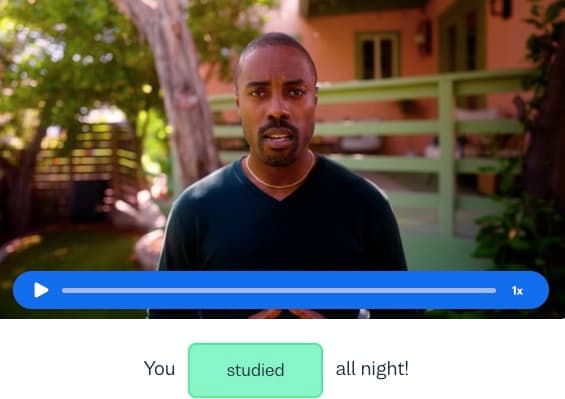I want to learn...
Author:

Angela Martinez
You’ve been mastering the indicative mood from your first English lesson and you didn’t even know it!
That’s right – most of what we say in English is communicated in this grammatical mood. So, if you’ve already got the hang of the indicative mood, what’s there to learn? In fact, there’s a lot more you’ve got to know!
In this article, we’ll discuss the indicative mood in more detail to help you understand it in-depth. You’ll read some indicative mood examples, and you’ll also learn the difference between the indicative mood and other grammatical moods in English.
What is the indicative mood?
Before diving into the indicative mood, we need to understand what a grammatical mood is.
Grammatical moods help us identify the intention of the phrase – what your sentence is meant to do. Are you stating a fact? Are you giving a command? Are you expressing a wish, a hypothetical situation or a request?
Understanding grammatical moods helps give our speech and writing another layer of meaning to better express what we want to say. They also help us become better acquainted with sentence structure in English, which can get a bit tricky when we’re discussing complex ideas.
Using the indicative mood
As the name says, we use the indicative mood to ‘indicate’ or state a fact, an opinion or an idea about what we think, see, or feel. In other words, most of what we have to say is written in the indicative mood. Sentences formed in the indicative mood are often called declarative statements since they “declare” or state a fact of what is or is not factual.
Sentences in the indicative mood don’t have a standard structure beyond including a subject and verb. You can also add modals like can, may or should, among others, to express obligations, abilities or permission. (Did you know that modals can be used as question words, too? Check out our article on questions words to find out how!)
Negative statements, which have a different structure from positive statements, are also considered to be in the indicative mood.
Indicative mood examples
It’s important to understand that grammatical moods and verb tenses are NOT the same thing.
Grammatical moods help us understand WHAT we want to say – is it a fact or opinion, a command, a wish or something else? Verb tenses (past, present, future) tell us WHEN something happened, will happen or is happening.
Sentences in the indicative mood can be stated in all verb tenses. Take a look at these indicative mood examples, both positive and negative statements, to better understand this grammatical mood:
(present simple)
The weather is beautiful today.
My neighbor doesn’t have any pets.
(past simple)
I called you last week.
We didn’t arrive in time for the flight.
(past perfect)
The children had fallen asleep.
The dishes hadn’t been cleaned.
(The indicative mood is also used with the passive voice! Take a look at how we form the passive voice in English)
(past continuous)
We were making dinner.
The employees weren’t listening to the instructions.
(present perfect)
My family and I have lived in this house for 20 years.
She hasn’t graduated from university yet.
(present continuous)
You are making my favorite cake!
The washing machine isn’t working well anymore.
(future)
The neighbors will host a party next Christmas.
I will not work this weekend.
(future perfect)
We’ll have eaten all these chocolates before we get home.
The show will not have ended by the time the speech starts.
(For a thorough review of tenses, take a look at this breakdown of verb tenses in English.)
In all the examples above, you’re using the indicative mood to state an observation, a fact or an opinion about the world around you. You’re doing so in different verb tenses, too!
Other grammatical moods
The best way to understand the indicative mood, beyond examples like those we’ve given, is to look at the other grammatical moods and how they differ from the indicative mood in what they express and how they’re written.
The imperative mood
The imperative mood is used to give commands. It is directed at the second person (you, singular & plural). The imperative mood sentence structure does not require a subject, as you can see in the following examples:
Give me my phone.
Clean the dishes.
Don’t drive slowly.
Commands can be made to sound more polite by adding words like ‘please.’ (To learn more about how to sound polite in different scenarios, check out our article on how to use formal language.)
You’ll also use the imperative mood for common situations like giving directions or instructions.
Go left. Turn right.
Pour the milk into the container. Whisk in some eggs.
Verbs in the imperative mood are written in the bare infinitive form (the verb without ‘to’). The imperative mood is only used to express an action in the present moment. Read our guide on imperative verbs to create more sentences in this mood.
The subjunctive mood
The subjunctive mood is used to express a desire, doubt, regret or request. The situations expressed through the subjunctive are hypothetical (meaning they are not real, but imagined) and focus on the desired reality rather than actual reality.
Mostly, phrases in the subjunctive mood are stated or written as a subordinating clause with the subjunctive or base form of the verb, following phrases with verbs like wish, suggest or regret or phrases like it’s necessary or it’s important. The subordinating clause is normally introduced by the word ‘that,’ as in the second and third examples below.
I wish he were on time as he promised.
We suggested that he take a break from work after the move.
It’s important that the children not be awake after 9 pm.
Though the subjunctive is not as clear cut in English as it is in other languages, there are clues in the sentence structure (such as the use of the base form of the verb and the word that) that can help us recognize the subjunctive mood.
With more practice, you’ll learn to identify phrases and sentences written in the subjunctive mood and distinguish them more easily from sentences written in the indicative mood.
The conditional mood
Like the subjunctive mood, the conditional mood helps us express a hypothetical situation. However, the conditional mood introduces a necessary circumstance that should occur for this hypothetical to be a reality.
The condition is presented as an ”IF” clause at the beginning of the sentence or following the main clause (the result of the condition being true). The main clause, in turn, contains the word will, would, could, can, or other modals.
If I finish my work early tomorrow (condition), I will go shopping (result).
The company could be successful (result) if they knew their customers better (condition).
If we hadn’t overslept (condition), we would have caught the bus on time (result)!
You’ll notice that with the conditional mood, some hypothetical situations can occur (I might finish my work early tomorrow), and others are not likely to happen (I can’t go back in time and not oversleep).
Grammatical moods and asking questions
So far, we’ve covered the main grammatical moods in English: the indicative mood, the imperative mood, the subjunctive mood, and the conditional mood.
All of these moods can be expressed in both positive and negative statements. Additionally, we can use question structure, or what is sometimes referred to as the interrogative mood, to pose questions in different moods depending on what we want to express.
How many languages do you speak?
(asking about a fact - indicative mood)
Could you lend me your phone, please?
(Expressing a command as a polite question - imperative mood)
"Would it be expected that we dress up for virtual job interviews?
(Asking about an expectation - subjunctive mood)
Where would you live if you were a millionaire?
(Asking for the result of a hypothetical situation - conditional mood)
Learning the different question structures in English will help you create more sentences in the different moods as shown above.
The indicative mood: A summary
To sum up, remember that grammatical moods help us convey different intentions by expressing facts or opinions through the indicative mood, commands with the imperative mood, wishes or regrets and other hypothetical situations with the subjunctive mood, and conditions and consequent results with the conditional mood.
The indicative mood is what we use most frequently in English, and we use this form for both positive and negative statements. It is used in all the verb tenses, as shown in the indicative mood examples we looked at earlier. Most of the questions we ask are also in the indicative mood, but some questions can also be conveyed in the other three moods.
We’re certain that you’ll enjoy saying what’s on your mind with more ease now that you’ve got the hang of grammatical moods. Keep practicing!
Dive deeper into more advanced English grammar topics
Join Busuu and get feedback from our community of native speakers who are excited to support you on your language-learning journey. Our complete English course and specialized English courses cover grammar from the beginning to the advanced level, helping you become more confident and fluent in your English ability.
AUTHOR

Angela Martinez
Newlanguages


